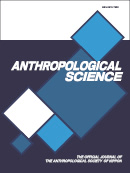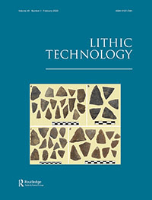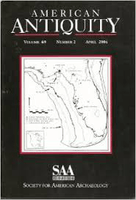
Time & Mind-The Journal of Archaeology Consciousness and Culture
Scope & Guideline
Charting New Territories in Archaeology and Consciousness
Introduction
Aims and Scopes
- Interdisciplinary Approaches:
The journal promotes research that integrates various disciplines such as cognitive neuroscience, anthropology, and performance theory to analyze archaeological findings and their implications for human consciousness. - Sensory Archaeology:
A significant focus is placed on sensory experiences and materiality, exploring how sensory engagements with objects and landscapes influence human cognition and cultural practices. - Cultural and Temporal Dynamics:
Research often delves into how concepts of time and cultural narratives shape human interactions with the environment, including the examination of calendars, rituals, and spatial boundaries. - Exploration of Myth and Symbolism:
The journal encourages studies that interpret archaeological artifacts and sites through the lens of myth, cosmology, and symbolic meanings, contributing to a deeper understanding of ancient belief systems. - Material Culture and Consciousness:
There is a consistent focus on how material culture informs human consciousness, reflecting on the cognitive and emotional dimensions of engaging with archaeological materials.
Trending and Emerging
- Sensory and Affective Engagements:
Recent publications increasingly explore how sensory experiences and emotional engagements with archaeological materials influence our understanding of the past, showcasing a growing interest in sensory archaeology. - Interdisciplinary Collaborations:
There is a notable trend towards interdisciplinary collaborations, where researchers from diverse fields come together to explore complex questions related to cognition, culture, and materiality. - Environmental and Anthropocene Studies:
Emerging themes focus on the relationships between human actions and environmental changes, particularly in the context of the Anthropocene, reflecting a growing awareness of sustainability and ecological impacts. - Temporal Dynamics in Archaeological Contexts:
An increasing emphasis on exploring the concept of time in archaeological contexts, including studies on calendars, rituals, and how past societies perceived and interacted with time. - Cognitive Approaches to Archaeology:
A rising interest in cognitive archaeology is evident, with research examining how cognitive processes shape human experiences and cultural expressions in the archaeological record.
Declining or Waning
- Traditional Archaeological Methodologies:
There seems to be a reduced focus on conventional archaeological methods and techniques, as the journal increasingly favors theoretical and interdisciplinary approaches over purely empirical studies. - Historical Narratives without Cognitive Context:
Research that solely emphasizes historical narratives without integrating cognitive or sensory perspectives appears to be less frequent, indicating a shift towards more holistic interpretations. - Static Interpretations of Archaeological Sites:
There is a decline in studies that present static interpretations of archaeological sites without considering their dynamic cultural and temporal contexts, as the journal moves towards more fluid and relational understandings.
Similar Journals

ANTHROPOLOGICAL SCIENCE
Pioneering research that shapes the future of anthropology.ANTHROPOLOGICAL SCIENCE is a prominent journal in the field of anthropology, published by the Anthropological Society of Nippon since 1993. With a rich pedigree of scholarly contributions, this journal is an essential platform for disseminating research findings and theoretical discussions that push the boundaries of anthropological knowledge. Currently ranked in the Q3 category in Anthropology by 2023 metrics, ANTHROPOLOGICAL SCIENCE boasts an impressive position at #163 out of 502 in Scopus, placing it in the 67th percentile among its peers. While it operates under a traditional access model, the journal supports a diverse range of anthropological research encompassing cultural, biological, and archaeological perspectives. Researchers, professionals, and students will find valuable insights and innovative methodologies that foster a richer understanding of human societies and behaviors. The current trends and findings published in this journal make it a crucial resource for those involved in anthropological studies or related fields.

Lucentum
A Beacon of Scholarly ExcellenceLucentum is a distinguished open-access journal published by Universidad de Alicante, focusing on the interdisciplinary fields of Archeology, History, and Paleontology. Since its inception in 1982, it has established itself as a vital platform for scholars and researchers to disseminate their findings, contributing significantly to the academic landscape in Spain and beyond. The journal's notable rankings, including Q1 status in History and Q2 in Archeology, reflect its commitment to high-quality scholarship and rigorous peer review. With an impressive impact factor and recognition in Scopus, Lucentum serves as an essential resource for professionals, students, and historians, fostering a deeper understanding of cultural and historical contexts through a wealth of interdisciplinary research. The journal continues to embrace open access, ensuring that critical knowledge is freely available to the global research community.

JOURNAL OF EGYPTIAN ARCHAEOLOGY
Illuminating the Secrets of Egypt's PastJOURNAL OF EGYPTIAN ARCHAEOLOGY is a premier publication dedicated to advancing the study of ancient Egyptian culture, artifacts, and historical contexts. Published by SAGE PUBLICATIONS LTD in the United Kingdom, this journal has been an authoritative source of archaeological scholarship since its inception in 1964. It boasts an impressive reputation, currently holding a Q3 ranking in Archeology and Q2 rankings in both Archeology (arts and humanities) and History for 2023, underlining its importance in its field. With a focus on interdisciplinary research, the journal provides a platform for in-depth analysis and discussion among scholars, researchers, and students alike. The journal is also indexed in Scopus, with notable rankings that reflect its influence and reach within the academic community, especially among arts and humanities disciplines. Although it is not an Open Access publication, the insights offered through its meticulously curated articles are invaluable for anyone looking to deepen their understanding of Egyptology and archaeological practices. For scholars seeking to engage with contemporary discussions in this fascinating field, the JOURNAL OF EGYPTIAN ARCHAEOLOGY serves as an essential resource.

Antropologia Portuguesa
Connecting Researchers to the Pulse of AnthropologyAntropologia Portuguesa, published by COIMBRA UNIV PRESS, is a distinguished open access journal in the field of anthropology, with an ISSN of 0870-0990 and an E-ISSN of 2182-7982. Based out of Coimbra, Portugal, this journal has been a vital resource for researchers and enthusiasts in the anthropological community since transitioning to an open access model in 2012, allowing for broader dissemination and accessibility of knowledge. With its diversified publications spanning from 2011 to 2023, it is well-established within the academic landscape, achieving a Q3 category rank in anthropology as of 2023, and holding a Scopus ranking of #376 out of 502 in the Social Sciences category, placing it within the 25th percentile. The journal aims to foster interdisciplinary dialogue and promote innovative research, offering a platform for the exploration of various anthropological themes and practices. As it continues to contribute to the scholarship in anthropology, Antropologia Portuguesa is an invaluable resource for researchers, professionals, and students committed to understanding cultural dynamics and human behavior on a global scale.

Origini
Bridging the Gap Between Past and Present Knowledge.Origini is a distinguished journal dedicated to the field of archaeology, published by EDIZIONI QUASAR S TOGNON SRL in Italy. With an ISSN of 0474-6805, it offers a platform for researchers and professionals to share their latest findings and insights. Having achieved a significant Q2 ranking in both Archaeology (Arts and Humanities) and Archaeology (Social Sciences) categories according to Scopus, it positions itself as a respected source of scholarly communication in the discipline. Over the converged years from 2017 to 2023, Origini has consistently aimed to advance archaeological research, fostering an environment where innovative theories and methodologies can be developed and discussed. Although it is not an Open Access journal, its contributions remain vital for academics and students seeking to deepen their understanding of archaeological practices and historical narratives. With a commitment to excellence, Origini stands as an essential resource within the archaeological community, inviting contributions that push the boundaries of knowledge and interpretation.

Lithic Technology
Elevating the Discourse in Archaeological LithicsLithic Technology is a premier international journal published by Routledge Journals, Taylor & Francis Ltd, dedicated to advancing the field of lithic studies in archaeology and anthropology. Established in 1977, this prestigious journal has established itself at the forefront of research concerning stone tool technology, providing a vital forum for scholars to share groundbreaking findings and methodologies. With an impressive Q1 ranking in both Archaeology and Anthropology, and indexed within the 91st percentile in its respective categories by Scopus, Lithic Technology is recognized for its significant contributions to the understanding of human prehistory and material culture. The journal features a diverse array of articles, from theoretical approaches to practical case studies, ensuring relevance to contemporary archaeological discourse. Though not an open-access publication, its meticulous peer-review process guarantees the highest quality of scholarship, making it an indispensable resource for researchers, professionals, and students eager to expand their knowledge in the rigors of lithic analysis.

AMERICAN ANTIQUITY
Exploring America's Past, Enriching Its Future.AMERICAN ANTIQUITY, published by Cambridge University Press, stands as a premier journal in the fields of archaeology, arts and humanities, history, and museology. With an enduring legacy since its inception in 1935, this journal has consistently ranked in the Q1 category across several disciplines, reflecting its significant impact and authority in shaping contemporary scholarly discourse. It boasts impressive Scopus rankings, placing it in the 99th percentile for archaeology and history, which underscores its critical role in advancing research and understanding of American archaeology and related fields. Although it does not currently offer open-access options, the journal remains a vital resource for researchers, professionals, and students seeking high-quality, peer-reviewed content. As it converges toward 2024, AMERICAN ANTIQUITY continues to foster innovative scholarship and preserve knowledge, making it an essential reading for anyone invested in the exploration of cultural heritage and historical narratives.

ARCHAEOMETRY
Exploring the Material Culture of Our Ancestors.ARCHAEOMETRY, published by WILEY, is a premier journal that has established itself at the forefront of research in the fields of archaeology and history since its inception in 1958. With an impressive Q1 ranking in both Archaeology and History for 2023, and notable Scopus rankings placing it in the top 98th percentile for History and the 91st percentile for Archaeology, this journal is an invaluable resource for researchers and professionals dedicated to advancing knowledge in these disciplines. The journal's comprehensive scope addresses a wide array of topics related to the materials and techniques used in archaeological investigation, fostering interdisciplinary dialogue and collaboration. Though not an open access publication, its impactful content is meticulously curated to promote scholarly excellence and innovation. By bridging the gap between science and the humanities, ARCHAEOMETRY plays a crucial role in unraveling the complexities of human pasts, making it an essential addition to the libraries of scholars and students alike.

Intersecciones en Antropologia
Connecting cultures through innovative research.Intersecciones en Antropologia, published by the Universidad Nacional del Centro de la Provincia de Buenos Aires (UNICEN), Facultad de Ciencias Sociales, is a premier open-access journal in the field of anthropology, having established its presence since 2010. With an impressive impact factor and currently holding the distinguished Q1 quartile ranking in anthropology for 2023, this journal has quickly become a vital resource for scholars and practitioners alike, offering a platform for innovative research and critical discussion. The journal aims to advance anthropological scholarship by encouraging the dissemination of diverse perspectives and stimulating dialogue across geographical and cultural boundaries. Its open-access model, adopted in 2017, ensures that valuable research findings are accessible to a global audience, fostering collaboration and engagement within the academic community and beyond. Located in the vibrant cultural context of Argentina, Intersecciones en Antropologia serves as a conduit for significant anthropological dialogues, making it an essential read for those dedicated to understanding and contributing to the evolving landscape of social sciences.

Relaciones
Connecting Ideas, Transforming Anthropology.Relaciones is a prestigious open-access journal published by the SOC ARGENTINA ANTROPOLOGIA, dedicated to the field of anthropology. Since its inception in 1937, this journal has served as a vital platform for disseminating innovative research and insights within the social sciences community. With both its print (ISSN: 0325-2221) and online (E-ISSN: 1852-1479) formats, Relaciones ensures widespread accessibility, empowering researchers, professionals, and students to engage with contemporary anthropological discourse. The journal aims to foster critical discussions that not only reflect on cultural and societal issues but also contribute to theoretical advancements in anthropological methodologies. By maintaining a commitment to quality and open access, Relaciones plays a crucial role in shaping the future of anthropology in Argentina and beyond, encouraging scholarly collaboration and enriching the academic landscape.